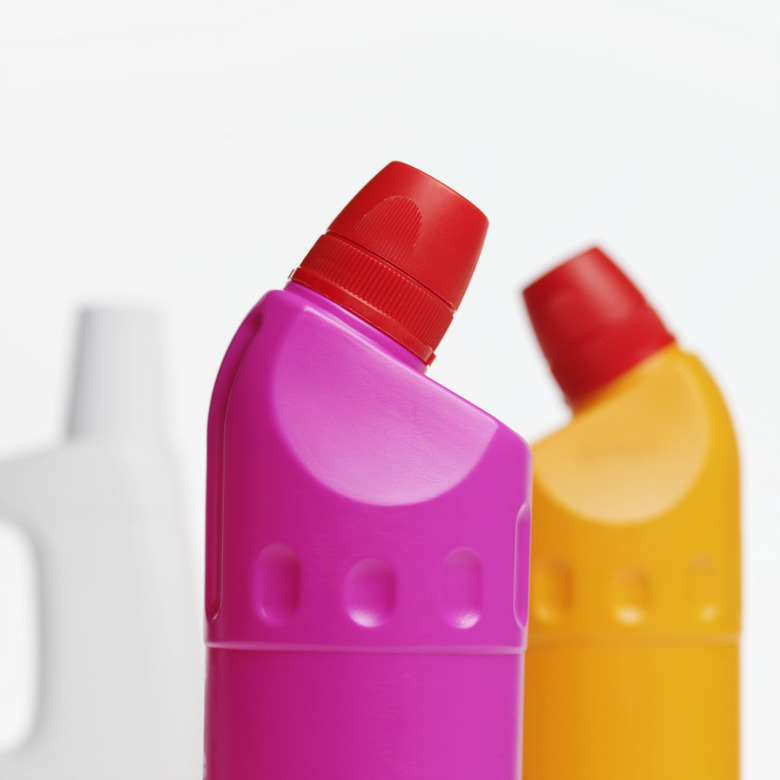What Color Does pH Paper Turn With Bleach?
While you may not think much about the cleaning products you use, knowing their chemistry can sometimes be helpful to know whether the product being used is an acid or base. Many spills tend to be acidic, and alkaline substances would be able to neutralize and remove the soil. Also, alkalines are better at dissolving fats and oils. Knowing the pH of a cleaning product like bleach can help with its uses as well as handling the solution safely.
pH Scale
pH Scale
Though pH does not have an upper or lower bound, the pH scale usually functions between 0 to 14, with 7 being neutral. A pH above 7 indicates a basic or alkaline substance, and those below 7 indicate acidity. The pH scale is logarithmic, meaning that with each individual number change on the scale there is a ten-fold change in acidity or alkalinity.
Acid and base indicators are sensitive to the change of pH, or more specifically, to the change in the concentration of hydrogen ions, H+, in solution. A pH scale measures the amount of H+, and the higher the pH value, the smaller the amount of H+ in the solution.
Litmus Paper
Litmus Paper
One common acid and base indicator is litmus paper, created by treating filter paper with a dye obtained from lichens. A solution applied to litmus paper will either keep the litmus the same color or change it. The litmus indicator is not able to determine a pH value, only to distinguish between acids and bases.
Red litmus is a weak diprotic acid, meaning it can donate two hydrogen atoms. Below pH 4.5, a red litmus paper stays red, but turns blue in a base. Above pH 8.3, a blue litmus paper stays blue but turns red in an acid. A neutral solution, or one between the upper and lower values of litmus paper, pH 4.5 and 8.3, will not change the paper's color.
pH Paper
pH Paper
Other pH paper exists that can give more precise pH results for the solution. This pH paper is universal indicator paper, and it contains a number of pH indicators such as methyl red, phenolphthalein and bromothymol blue. The combination of indicators gives the paper the ability to determine an approximate pH of acids or bases.
In the presence of a strong acidic solution, the pH paper will turn red, and if a strong alkaline or basic solution is applied, it will turn violet. Neutral solutions turn green. Different universal indicator papers exist, and the color changes may vary by manufacturer.
Testing With Litmus Paper or pH Paper
Testing With Litmus Paper or pH
Paper
A small amount of substance, preferably a drop from a dropper, should be placed on the paper strip. If testing on the small rectangular red or blue paper litmus strips, it is best to use both kinds to make sure one does not have a neutral solution.
When the color changes on the universal indicator pH paper, it can be compared to a reference scale supplied by the manufacturer to determine pH. It will usually be a whole number, such as pH 1, 2, 3 and so on until pH 14.
pH of Bleach and pH Papers
pH of Bleach
and pH Papers
Liquid bleach is a common household cleaner and is also commonly used as a stain remover or for disinfecting surfaces, as it is highly effective in eliminating various types of bacteria and viruses. It has a yellow or greenish color, and the bleach chemical formula is NaClO. Bleach is chemically known as sodium hypochlorite.
The pH of bleach is approximately 11, a strongly alkaline, or basic, solution. Placed on red litmus paper, it will turn it blue. The blue litmus paper won't change color. With the pH paper, bleach will turn the color violet, indicating a strong alkaline solution.
While it is a common household cleaner, concentrated bleach should be handled safely. Eye and skin protection are suggested to avoid skin exposure, and a well-ventilated area will avoid vapor build-up that can cause eye and respiratory irritation.
Cite This Article
MLA
Kozlowski, Rosann. "What Color Does pH Paper Turn With Bleach?" sciencing.com, https://www.sciencing.com/color-ph-paper-turn-bleach-12611/. 26 March 2020.
APA
Kozlowski, Rosann. (2020, March 26). What Color Does pH Paper Turn With Bleach?. sciencing.com. Retrieved from https://www.sciencing.com/color-ph-paper-turn-bleach-12611/
Chicago
Kozlowski, Rosann. What Color Does pH Paper Turn With Bleach? last modified March 24, 2022. https://www.sciencing.com/color-ph-paper-turn-bleach-12611/
